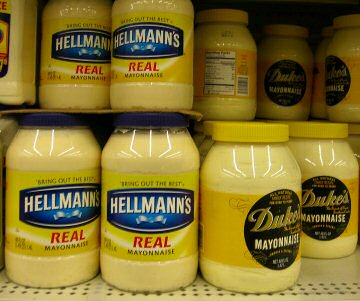
Homemade classic French-style mayonnaise is a semi-solid emulsion of vegetable oil (typically olive) and egg yolk (or whole egg) with vinegar or lemon juice, seasoned with salt and pepper. Homemade mayonnaise is surprisingly flavorful and robust, but not frequently made nowadays because it contains raw egg.
(There is concern about salmonella poisoning from raw eggs. However, egg substitute can be used to make homemade mayonnaise. Commercial mayonnaise is made with pasteurized egg.)
Commercial mayonnaise contains similar ingredients to the classic French mayonnaise, often with the addition of spices and sugar. Many commercially-made brands are available in the United States: Hellmann's/Best Foods, Kraft, Duke's, Blue Plate, etc. Southerners often use Hellmann's, which, interestingly enough, was first produced in New York City. There, in 1905, German immigrant Richard Hellmann opened a delicatessen. Salads sold at the deli contained mayonnaise which his wife Nina made. Soon the condiment itself became so popular that Hellmann started selling it separately.
Some say that a mayonnaise-like mixture of olive oil and egg can be traced back to Roman times, or even to early Egyptian culture. However, mayonnaise as we know it seems to have been developed in France.
According to one story, it was invented in 1756 to commemorate a victory at the start of the Seven Years War, the successful siege of English-held St. Philip's Castle. Located in Mahón, port city and the capital of Minorca, its loss resulted in the loss of the entire island. French Admiral La Galissoniére and Louis François Armand de Vignerot du Plessis, duc de Richelieu, commanded the siege, after which a sauce was christened “mahonnaise.” Perhaps the so-named sauce debuted at a banquet in honor of Richelieu.
Other theories concerning the origin of the name “mayonnaise” abound:
At any rate, the condiment became popular in France, and before long the recipe was known in England and subsequently in the United States. As Brillat-Savarin said, “The discovery of a new dish does more for human happiness than the discovery of a new star.”
Copyright © 2002–2006 Patricia B. Mitchell.